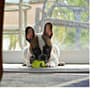Podcast
Questions and Answers
What is the main difference between a grade I and a grade III sprain?
What is the main difference between a grade I and a grade III sprain?
- The amount of bleeding and swelling
- The severity of the pain
- The impact on range of motion
- The degree of ligamentous fibre damage (correct)
What is a potential consequence of severe sprains on a joint?
What is a potential consequence of severe sprains on a joint?
- Improved synovial fluid production
- Decreased swelling
- Increased stability
- Reduced range of motion (correct)
What characterizes a strain injury?
What characterizes a strain injury?
- Tearing of muscle fibres or the muscle's tendon (correct)
- Damage to blood vessels and nerves
- Rupture of the synovial fluid
- Tearing of ligaments
What is a possible consequence of immobilizing a severe sprain for up to three weeks?
What is a possible consequence of immobilizing a severe sprain for up to three weeks?
What is the main reason for more bleeding in strains compared to sprains?
What is the main reason for more bleeding in strains compared to sprains?
What does a complete rupture of a muscle lead to?
What does a complete rupture of a muscle lead to?
How long does healing typically take for strains?
How long does healing typically take for strains?
What is an important point to note about pain subsiding in strains and sprains?
What is an important point to note about pain subsiding in strains and sprains?
What is the cause of cramps in muscles?
What is the cause of cramps in muscles?
When do cramps commonly occur in muscles?
When do cramps commonly occur in muscles?
What does the term 'stiff muscles' refer to?
What does the term 'stiff muscles' refer to?
What does 'stiff joints' mean?
What does 'stiff joints' mean?
Why do joints sometimes become stiff when immobilized?
Why do joints sometimes become stiff when immobilized?
What results from stiffness after surgery without intervention?
What results from stiffness after surgery without intervention?
What are cramps often associated with?
What are cramps often associated with?
What is one advantage of passive stretching over active stretching?
What is one advantage of passive stretching over active stretching?
When is active stretching more viable than passive stretching?
When is active stretching more viable than passive stretching?
What type of stretches are useful to combat mild stiffness in joints?
What type of stretches are useful to combat mild stiffness in joints?
In what situations may passive stretches be better for treating lower limb joints?
In what situations may passive stretches be better for treating lower limb joints?
Why is it important to seek medical approval before implementing any post-surgery stretches?
Why is it important to seek medical approval before implementing any post-surgery stretches?
Why are all forms of stretching contraindicated during the acute stage after surgery?
Why are all forms of stretching contraindicated during the acute stage after surgery?
Why is it important to begin a gentle stretching program sooner rather than later in the sub-acute post-surgical stage?
Why is it important to begin a gentle stretching program sooner rather than later in the sub-acute post-surgical stage?
What is the purpose of elevating an upper limb or lower limb after surgery?
What is the purpose of elevating an upper limb or lower limb after surgery?
What should the client avoid when performing active stretches post-surgery?
What should the client avoid when performing active stretches post-surgery?
What does pain during stretching post-surgery indicate?
What does pain during stretching post-surgery indicate?
What is the rationale behind beginning a gentle stretching program sooner rather than later in the sub-acute post-surgical stage?
What is the rationale behind beginning a gentle stretching program sooner rather than later in the sub-acute post-surgical stage?
Why should stretches always be within the client’s pain-free range, whether active or passive?
Why should stretches always be within the client’s pain-free range, whether active or passive?
What type of stretching is contraindicated during the early stages of healing for all forms of sprains and strains?
What type of stretching is contraindicated during the early stages of healing for all forms of sprains and strains?
What is the primary rationale behind employing a gentle active stretching program for sub-acute sprains and strains?
What is the primary rationale behind employing a gentle active stretching program for sub-acute sprains and strains?
What does elevation of the injured joint or limb assist in?
What does elevation of the injured joint or limb assist in?
What is the recommended approach when performing stretches for muscle cramps?
What is the recommended approach when performing stretches for muscle cramps?
Why are passive stretches sometimes helpful for muscle cramps?
Why are passive stretches sometimes helpful for muscle cramps?
What is the usefulness of both active and passive stretches for mild tight muscles?
What is the usefulness of both active and passive stretches for mild tight muscles?
For chronic tight muscles, what may serve as a prophylactic to worsening joint stiffness in some clients?
For chronic tight muscles, what may serve as a prophylactic to worsening joint stiffness in some clients?
What may increase muscle tone in some people, making it difficult to overcome chronic tightness?
What may increase muscle tone in some people, making it difficult to overcome chronic tightness?
What is the appropriate intervention for ankylosing spondylitis, a condition where joints fuse together over time?
What is the appropriate intervention for ankylosing spondylitis, a condition where joints fuse together over time?
What condition is characterized by pain, swelling, and stiffness in the small joints of the fingers and toes?
What condition is characterized by pain, swelling, and stiffness in the small joints of the fingers and toes?
What is the term for tendon problems resulting from overuse, which are very painful but lack certain cellular characteristics indicative of inflammation?
What is the term for tendon problems resulting from overuse, which are very painful but lack certain cellular characteristics indicative of inflammation?
What conditions are believed to be the result of fascial changes?
What conditions are believed to be the result of fascial changes?
Which surgical procedure involves using stretches post-surgically for one upper limb condition and one lower limb condition?
Which surgical procedure involves using stretches post-surgically for one upper limb condition and one lower limb condition?
What can happen if collagen is stretched too early in the repair process after surgery?
What can happen if collagen is stretched too early in the repair process after surgery?
What is contraindicated for clients suffering from rheumatoid arthritis during inflammatory periods?
What is contraindicated for clients suffering from rheumatoid arthritis during inflammatory periods?
What is the term for treatments aimed at bringing about changes in fascia, generally known as myofascial release techniques?
What is the term for treatments aimed at bringing about changes in fascia, generally known as myofascial release techniques?
Which condition involves compression of nerves and can be found in chapter 6 of the text?
Which condition involves compression of nerves and can be found in chapter 6 of the text?
What is the potential consequence of stretching collagen too early after surgery?
What is the potential consequence of stretching collagen too early after surgery?
What is the appropriate intervention for adhesive capsulitis, a condition characterized by shoulder joint stiffening with no known cause?
What is the appropriate intervention for adhesive capsulitis, a condition characterized by shoulder joint stiffening with no known cause?
What is the term for tendon problems resulting from overuse, which have fewer inflammatory markers than expected on microscopic examination?
What is the term for tendon problems resulting from overuse, which have fewer inflammatory markers than expected on microscopic examination?
Flashcards are hidden until you start studying
Study Notes
Sprains and Strains
- A grade I sprain is a mild stretch or tear of a ligament, while a grade III sprain is a complete tear or rupture.
- Severe sprains can lead to chronic joint instability and osteoarthritis.
- A strain is a stretch or tear of a muscle or tendon, characterized by pain, swelling, and limited mobility.
Consequences and Healing
- Immobilizing a severe sprain for up to three weeks can lead to joint stiffness and increased risk of osteoarthritis.
- Strains typically take longer to heal than sprains, with healing times ranging from several weeks to several months.
- Pain subsiding in strains and sprains does not necessarily mean the injury is fully healed.
Muscle Cramps and Stiffness
- Muscle cramps are caused by muscle spasms, often due to fatigue, dehydration, or electrolyte imbalances.
- Cramps commonly occur in muscles during intense exercise or in cold weather.
- Stiff muscles refer to reduced flexibility and range of motion, while stiff joints refer to reduced mobility and pain.
- Joints can become stiff when immobilized due to lack of movement and lubrication.
- Stiffness after surgery can lead to adhesions and chronic pain if left untreated.
Stretching and Exercise
- Passive stretching is beneficial for severe sprains and strains, while active stretching is more viable for mild injuries.
- Gentle stretches can help combat mild stiffness in joints, and passive stretches may be better for treating lower limb joints.
- It is essential to seek medical approval before implementing any post-surgery stretches, and all forms of stretching are contraindicated during the acute stage after surgery.
- Elevating an upper or lower limb after surgery can reduce swelling and promote healing.
Post-Surgery Care
- Pain during stretching post-surgery indicates that the stretch is too aggressive or that the client is not ready for stretching.
- A gentle stretching program should begin sooner rather than later in the sub-acute post-surgical stage to promote healing and prevent chronic stiffness.
- Stretches should always be within the client's pain-free range, whether active or passive.
Conditions and Interventions
- Ankylosing spondylitis is a condition where joints fuse together over time, and gentle stretching and exercise are recommended.
- Psoriatic arthritis is characterized by pain, swelling, and stiffness in the small joints of the fingers and toes.
- Tendinosis is a condition where tendons are damaged due to overuse, lacking certain cellular characteristics indicative of inflammation.
- Fascial changes are believed to be the result of conditions such as plantar fasciitis.
- Myofascial release techniques are treatments aimed at bringing about changes in fascia.
- Adhesive capsulitis, a condition characterized by shoulder joint stiffening with no known cause, is treated with gentle stretching and exercise.
Surgical Procedures
- Surgical procedures, such as rotator cuff repair and anterior cruciate ligament (ACL) reconstruction, involve using stretches post-surgically to promote healing and prevent chronic stiffness.
- Stretching collagen too early in the repair process after surgery can lead to further injury and delayed healing.
Studying That Suits You
Use AI to generate personalized quizzes and flashcards to suit your learning preferences.




